I was getting so many birds in Colombia that my posts will have to split into 2-3 installments per day! After KM4 we started to head east towards the Guajira Peninsula which is a relatively dry and thorny habitat. One thing I need to get off my chest is the garbage. When driving through towns I was really shocked at how much plastics and garbage in general was strewn across an otherwise beautiful landscape. I realize the people don't have the infrastructure to have garbage hauled but there has to be something they can do to at least keep it restricted to some area of town. I have been to many places with poor populations but I have to say this was the worst conditions I have ever seen. Some of the rivers were so full of plastic that you couldn't see the surface of the water. I hope the Colombian government does something to improve this situation. They would have much more tourism dollars if they could just provide some semblance of garbage collection.
Anyway back to the nice parts of Colombia... Our next stop was the Via Parque Isla de Salamanca which is the home of a couple targets birds but most importantly one of the few locations where you can find the Sapphire-bellied Hummingbird. This particular hummingbird is similar to some other species nearby but the sapphire iridescence extends further down the belly. They live in the mangroves feeding on mangrove flowers. I was a little disappointed that it appeared the mangroves were not flowering at the time.
This Bicolored Conebill is one of the specialties found at this spot. It never came down from the canopy so I had to settle for this shot.
Pied Puffbird likewise was a target and it did not take long to find it.
Pied Water-tyrants were accommodating.
One more Yellow-chinned Spiketail posed for me.
A Lesser Nighthawk gave me cracking views which was nice because my previous looks in the Yucatan were high up flyovers.
This American Pygmy Kingfisher was a real prize and we had to be super quiet in order to entice it close enough and out of the thick growth.
Then finally at the end of the walk we found one flowering tree... and one of the crew found our quarry..
Sapphire-bellied Hummingbird - it definitely did not cooperate for good photos and only graced us with its presence for a short moment.
At lunch we stopped at an awesome roadside restaurant (Las Acacias) overlooking a beautiful stream that was flanked on both sides with mature trees and plenty of birds.
Green Kingfisher
The food was great too. Arroz con Camarones (Shrimp and Rice) became my go to food in Colombia as it was a pretty safe bet for keeping my intestines from erupting. Colombia like most of the Latin American countries has tap water that can host microbes that us northerners don't agree with. I especially try and avoid any salads when traveling as the lettuce is washed in local water. Luckily I stayed healthy up until the very end and I am pretty sure the salad on one of the last nights was the culprit. I was told in that particular case that the salad should be fine because the establishment was using purified water.
A finca most of the way to our next full stop provided probably one of the most rare birds of the trip. We stopped at this farm specifically to look for Blue-crowned Parakeets.
No this Bicolored Wren was not the rare bird.
This butterfly will have to wait on ID later.
This Aplomado Falcon was super backlit but was a nice find and the only one for the trip.
Blue-crowned Parakeets were flying overhead but did not want to sit out in the open for us.
In Colombia they have a pronounced white eye-ring and not much blue at all. In other parts of South America they have orange colored eye-rings and the crown is much more blue.
Whistling Heron - this was our red letter bird. Usually this bird is found on Llanos way further south in Colombia. It was super far in a field but we managed some great scope views.
A yellow-headed Caracara was being hassled by a lifer Fork-tailed Flycatcher.
For some reason I always thought Fork-tailed Flycatchers were huge but it turns out they are not much bigger than Eastern Kingbirds. This Eared Dove dwarfed the FTFL
Finally we found a Blue-crowned Parakeet sitting for us although the light was crap.
A little further along the road at a police checkpoint we stopped for some quick birding.
A couple of Green-rumped Parrotlets were canoodling.

The Fork-Tailed Flycatchers here were more willing to be photographed.
Groove-billed Ani
Carib Grackle
Carib Grackle female.
Rufous-vented Chachalacas
And then our final stop before we drove the rest of the way to our hotel for the night was one of my favorite birds of the trip.
Double-Striped Thick-knee - this cool shore bird is large and in charge.
Our hotel for the next 3 nights was in the coastal town of Riohacha. The next installments will be from spots around the scrub habitat near Riohacha.
Anyway back to the nice parts of Colombia... Our next stop was the Via Parque Isla de Salamanca which is the home of a couple targets birds but most importantly one of the few locations where you can find the Sapphire-bellied Hummingbird. This particular hummingbird is similar to some other species nearby but the sapphire iridescence extends further down the belly. They live in the mangroves feeding on mangrove flowers. I was a little disappointed that it appeared the mangroves were not flowering at the time.
This Bicolored Conebill is one of the specialties found at this spot. It never came down from the canopy so I had to settle for this shot.
Pied Puffbird likewise was a target and it did not take long to find it.
Pied Water-tyrants were accommodating.
One more Yellow-chinned Spiketail posed for me.
A Lesser Nighthawk gave me cracking views which was nice because my previous looks in the Yucatan were high up flyovers.
This American Pygmy Kingfisher was a real prize and we had to be super quiet in order to entice it close enough and out of the thick growth.
Then finally at the end of the walk we found one flowering tree... and one of the crew found our quarry..
Sapphire-bellied Hummingbird - it definitely did not cooperate for good photos and only graced us with its presence for a short moment.
At lunch we stopped at an awesome roadside restaurant (Las Acacias) overlooking a beautiful stream that was flanked on both sides with mature trees and plenty of birds.
Green Kingfisher
The food was great too. Arroz con Camarones (Shrimp and Rice) became my go to food in Colombia as it was a pretty safe bet for keeping my intestines from erupting. Colombia like most of the Latin American countries has tap water that can host microbes that us northerners don't agree with. I especially try and avoid any salads when traveling as the lettuce is washed in local water. Luckily I stayed healthy up until the very end and I am pretty sure the salad on one of the last nights was the culprit. I was told in that particular case that the salad should be fine because the establishment was using purified water.
A finca most of the way to our next full stop provided probably one of the most rare birds of the trip. We stopped at this farm specifically to look for Blue-crowned Parakeets.
No this Bicolored Wren was not the rare bird.
This butterfly will have to wait on ID later.
This Aplomado Falcon was super backlit but was a nice find and the only one for the trip.
Blue-crowned Parakeets were flying overhead but did not want to sit out in the open for us.
In Colombia they have a pronounced white eye-ring and not much blue at all. In other parts of South America they have orange colored eye-rings and the crown is much more blue.
Whistling Heron - this was our red letter bird. Usually this bird is found on Llanos way further south in Colombia. It was super far in a field but we managed some great scope views.
A yellow-headed Caracara was being hassled by a lifer Fork-tailed Flycatcher.
For some reason I always thought Fork-tailed Flycatchers were huge but it turns out they are not much bigger than Eastern Kingbirds. This Eared Dove dwarfed the FTFL
Finally we found a Blue-crowned Parakeet sitting for us although the light was crap.
A little further along the road at a police checkpoint we stopped for some quick birding.
A couple of Green-rumped Parrotlets were canoodling.

The Fork-Tailed Flycatchers here were more willing to be photographed.
Groove-billed Ani
Carib Grackle
Carib Grackle female.
Rufous-vented Chachalacas
And then our final stop before we drove the rest of the way to our hotel for the night was one of my favorite birds of the trip.
Double-Striped Thick-knee - this cool shore bird is large and in charge.
Our hotel for the next 3 nights was in the coastal town of Riohacha. The next installments will be from spots around the scrub habitat near Riohacha.

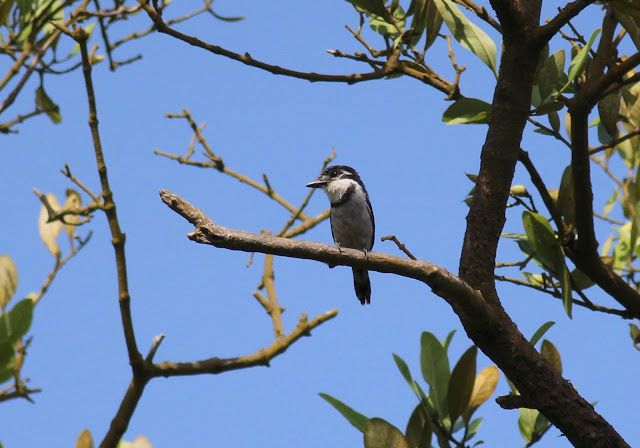


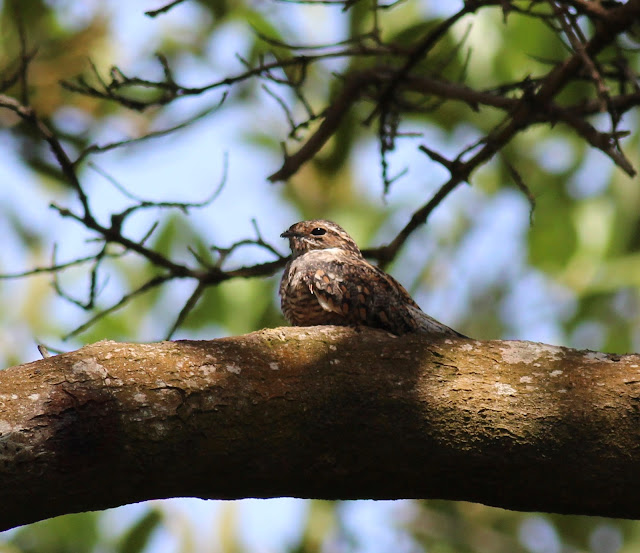



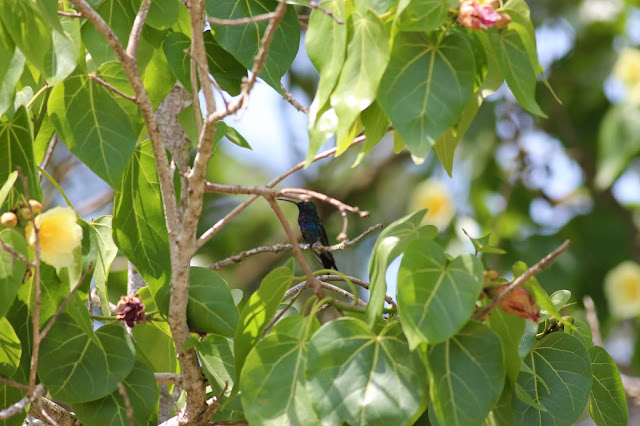









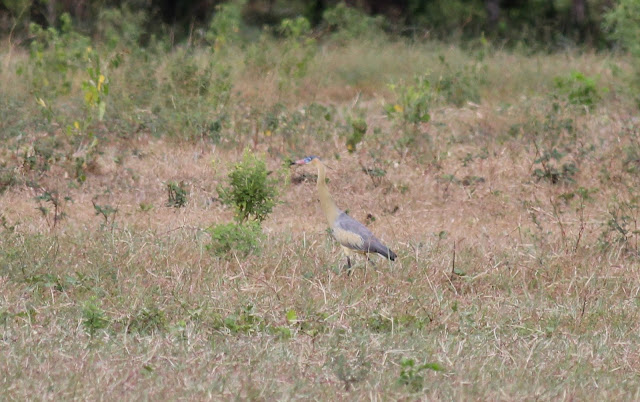
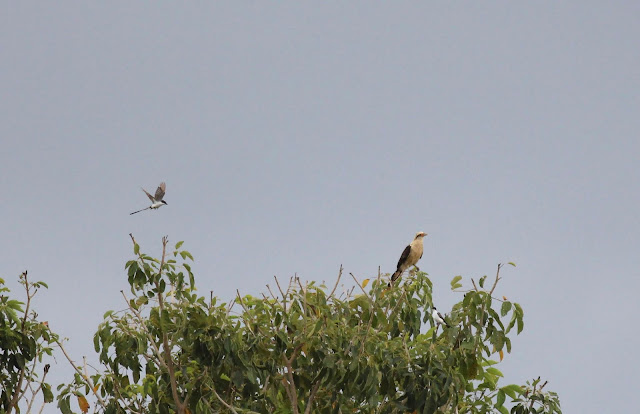








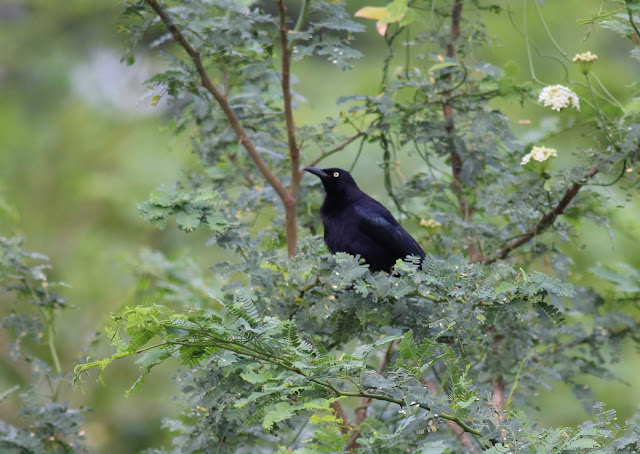







love the pigmy kingfisher!
ReplyDelete